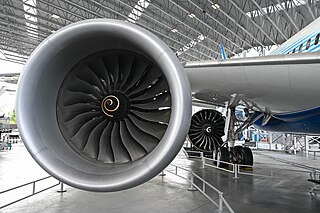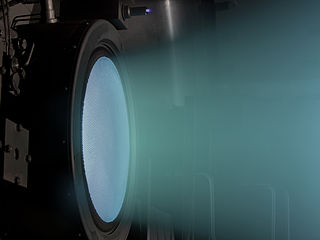Related Research Articles

Spacecraft propulsion is any method used to accelerate spacecraft and artificial satellites. In-space propulsion exclusively deals with propulsion systems used in the vacuum of space and should not be confused with space launch or atmospheric entry.
A resistojet is a method of spacecraft propulsion that provides thrust by heating a typically non-reactive fluid. Heating is usually achieved by sending electricity through a resistor consisting of a hot incandescent filament, with the expanded gas expelled through a conventional nozzle.

In spacecraft propulsion, a Hall-effect thruster (HET) is a type of ion thruster in which the propellant is accelerated by an electric field. Hall-effect thrusters are sometimes referred to as Hall thrusters or Hall-current thrusters. Hall-effect thrusters use a magnetic field to limit the electrons' axial motion and then use them to ionize propellant, efficiently accelerate the ions to produce thrust, and neutralize the ions in the plume. The Hall-effect thruster is classed as a moderate specific impulse space propulsion technology and has benefited from considerable theoretical and experimental research since the 1960s.

An ion thruster, ion drive, or ion engine is a form of electric propulsion used for spacecraft propulsion. It creates thrust by accelerating ions using electricity.

A magnetoplasmadynamic (MPD) thruster (MPDT) is a form of electrically powered spacecraft propulsion which uses the Lorentz force to generate thrust. It is sometimes referred to as Lorentz Force Accelerator (LFA) or MPD arcjet.
A pulsed plasma thruster (PPT), also known as a plasma jet engine, is a form of electric spacecraft propulsion. PPTs are generally considered the simplest form of electric spacecraft propulsion and were the first form of electric propulsion to be flown in space, having flown on two Soviet probes starting in 1964. PPTs are generally flown on spacecraft with a surplus of electricity from abundantly available solar energy.
Beam-powered propulsion, also known as directed energy propulsion, is a class of aircraft or spacecraft propulsion that uses energy beamed to the spacecraft from a remote power plant to provide energy. The beam is typically either a microwave or a laser beam and it is either pulsed or continuous. A continuous beam lends itself to thermal rockets, photonic thrusters and light sails, whereas a pulsed beam lends itself to ablative thrusters and pulse detonation engines.
Specific impulse is a measure of how efficiently a reaction mass engine creates thrust. For engines whose reaction mass is only the fuel they carry, specific impulse is exactly proportional to the effective exhaust gas velocity.
A solar thermal rocket is a theoretical spacecraft propulsion system that would make use of solar power to directly heat reaction mass, and therefore would not require an electrical generator, like most other forms of solar-powered propulsion do. The rocket would only have to carry the means of capturing solar energy, such as concentrators and mirrors. The heated propellant would be fed through a conventional rocket nozzle to produce thrust. Its engine thrust would be directly related to the surface area of the solar collector and to the local intensity of the solar radiation.

Laser propulsion is a form of beam-powered propulsion where the energy source is a remote laser system and separate from the reaction mass. This form of propulsion differs from a conventional chemical rocket where both energy and reaction mass come from the solid or liquid propellants carried on board the vehicle.

Solar electric propulsion (SEP) refers to the combination of solar cells and electric thrusters to propel a spacecraft through outer space. This technology has been exploited in a variety of spacecraft designs by the European Space Agency (ESA), the JAXA, Indian Space Research Organisation (ISRO) and NASA. SEP has a significantly higher specific impulse than chemical rocket propulsion, thus requiring less propellant mass to be launched with a spacecraft. The technology has been evaluated for missions to Mars.

The gridded ion thruster is a common design for ion thrusters, a highly efficient low-thrust spacecraft propulsion method running on electrical power by using high-voltage grid electrodes to accelerate ions with electrostatic forces.

Jet propulsion is the propulsion of an object in one direction, produced by ejecting a jet of fluid in the opposite direction. By Newton's third law, the moving body is propelled in the opposite direction to the jet. Reaction engines operating on the principle of jet propulsion include the jet engine used for aircraft propulsion, the pump-jet used for marine propulsion, and the rocket engine and plasma thruster used for spacecraft propulsion. Underwater jet propulsion is also used by several marine animals, including cephalopods and salps, with the flying squid even displaying the only known instance of jet-powered aerial flight in the animal kingdom.

A plasma propulsion engine is a type of electric propulsion that generates thrust from a quasi-neutral plasma. This is in contrast with ion thruster engines, which generate thrust through extracting an ion current from the plasma source, which is then accelerated to high velocities using grids/anodes. These exist in many forms. However, in the scientific literature, the term "plasma thruster" sometimes encompasses thrusters usually designated as "ion engines".

Spacecraft electric propulsion is a type of spacecraft propulsion technique that uses electrostatic or electromagnetic fields to accelerate mass to high speed and thus generate thrust to modify the velocity of a spacecraft in orbit. The propulsion system is controlled by power electronics.
A cold gas thruster is a type of rocket engine which uses the expansion of a pressurized gas to generate thrust. As opposed to traditional rocket engines, a cold gas thruster does not house any combustion and therefore has lower thrust and efficiency compared to conventional monopropellant and bipropellant rocket engines. Cold gas thrusters have been referred to as the "simplest manifestation of a rocket engine" because their design consists only of a fuel tank, a regulating valve, a propelling nozzle, and the little required plumbing. They are the cheapest, simplest, and most reliable propulsion systems available for orbital maintenance, maneuvering and attitude control.

The NASA Evolutionary Xenon Thruster (NEXT) project at Glenn Research Center is a gridded electrostatic ion thruster about three times as powerful as the NSTAR used on Dawn and Deep Space 1 spacecraft. It was used in DART, launched in 2021.

A liquid apogee engine (LAE), or apogee engine, refers to a type of chemical rocket engine typically used as the main engine in a spacecraft.

The NASA Solar Technology Application Readiness (NSTAR) is a type of spacecraft ion thruster called electrostatic ion thruster. It is a highly efficient low-thrust spacecraft propulsion running on electrical power generated by solar arrays. It uses high-voltage electrodes to accelerate ions with electrostatic forces.
Microwave electrothermal thruster, also known as MET, is a propulsion device that converts microwave energy into thermal energy. These thrusters are predominantly used in spacecraft propulsion, more specifically to adjust the spacecraft’s position and orbit. A MET sustains and ignites a plasma in a propellant gas. This creates a heated propellant gas which in turn changes into thrust due to the expansion of the gas going through the nozzle. A MET’s heating feature is like one of an arc-jet ; however, due to the free-floating plasma, there are no problems with the erosion of metal electrodes, and therefore the MET is more efficient.
References
- ↑ Erichsen, Peter (1997). "Performance Evaluation of Spacecraft Propulsion Systems in Relation to Mission Impulse Requirements". articles.adsabs.harvard.edu. Retrieved August 23, 2022.
- ↑ Erichsen, Peter (2007). "A Quick-Look Analysis Tool for the Impulse Performance of Spacecraft Propulsion Systems". CiteSeerX 10.1.1.489.9159 .
- ↑ Erichsen, Peter (September 2003). "Directions of Potential Increase in Impulse Performance of Spacecraft Propulsion Systems". Proceedings of the 10th International Workshop on Combustion and Propulsion. Lerici, La Spezia, Italy. S2CID 54691921.
- ↑ KOPPEL, Christophe; QUINSAC, Gary (2019). "Electric Thruster Selection Criteria" (PDF): 17 pages. doi:10.13009/EUCASS2019-805.
{{cite journal}}: Cite journal requires|journal=(help)